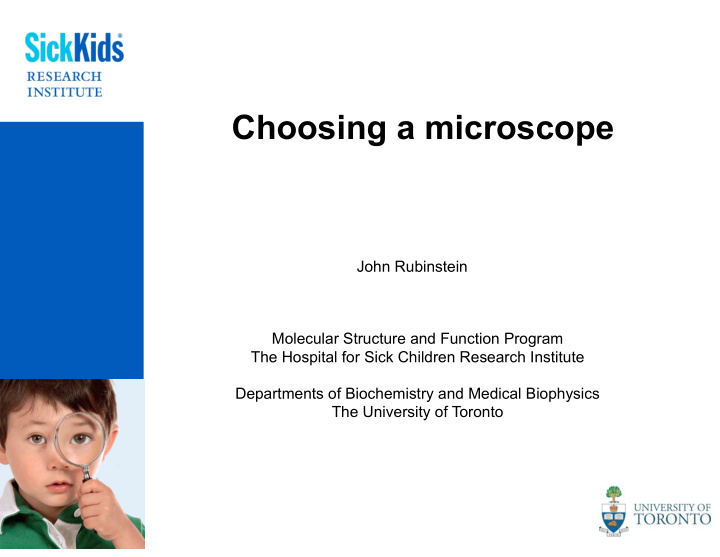



Choosing a microscope John Rubinstein Molecular Structure and Function Program The Hospital for Sick Children Research Institute Departments of Biochemistry and Medical Biophysics The University of Toronto
The questions: • What do you need? • How many people does each microscope serve? • How do you validate your instrument performance? • How do you schedule time to optimize the instrument usage and performance?
Context The University of Toronto: 67128 Undergraduate 15884 Graduates 12589 Faculty The Hospital for Sick Children Research Institute: 239 PIs (>50% Research Time) 313 PIs (<50% Research Time) 225 PDFs 449 Graduate students
Geographic factors U of T Medical Sciences Bldg (inc. Biochem, Mol Gen, Lab Med, U of T Tanz Neuroscience U of T Cell Biol U of T MaRS Phase II U of T CCBR Pharamacology Women’s College Hospital RI Structural Genomics Consortium MaRS Phase I Ontario Cancer Institute Toronto General Hospital RI Princess Margaret Toronto Cancer Centre Western Hospital for Sick Children RI Hospital RI Samuel Lunenfeld RI Hospital for Sick Children (Mt. Sinai Hospital) St. Michael’s Hospital RI
Vital statistics New PI: Do not set up a multi-user facility Choose your collaborations carefully Decision: 1 Group. 1 Microscope.
Microscope Installation February 2007
Microscope Installation February 2007
Current equipment Tecnai TF20 Installed February 2007 Gatan K2 Summit Installed June 2013
Group Size Z Staff MMJ Students Dan Schep Anna Zhou Postdocs Martin Smith Jason Koo Shawn Keating Jana Tuhman Jianhua Zhao Samir Benlekbir Nawaz Pirani Lindsay Baker Wilson Lau Stephanie Bueler 2006 2007 2008 2009 2010 2011 2012 2013 2014 2015
Microscope usage policy • Only book two regular sessions in advance • morning session: any time in the morning until 12:30 pm • afternoon session: 1 pm until any time in the evening • You may book as many weekend sessions in advance as you want (within reason and in discussion with other group members if necessary) • Negative stain sessions should be in the morning/Cryo- EM sessions should be in the afternoon
A busy week for the F20
A not so busy week for the F20
What do you need? • Good space for a microscope • A good microscope
New building: October 2013
Geographic factors Subway Streetcar
Sources of EMI 600 V
Big city magnetic fields
Big city magnetic fields
Choice of location Rubinstein Lab Low-frequency building sway Microscope sweet spot Magnetic fields
EM facility layout (expected completion Feb/Mar 2015)
EM facility vibration study FRONT TO BACK FLOOR VIBRATION VERTICAL FLOOR VIBRATION
EM facility EMI study VERTICAL EMI FRONT TO BACK EMI
Microscope room Feature Option 1 Option 2 Find location with Floor vibrations — acceptable level FInd location with Magnetic field Active cancellation system acceptable level Isolate/insulate room from Move noise generating Acoustic Noise noise sources components out of room Temperature stability Required — Humidty Keep below <20% RH —
Microscope options Feature Option 1 Option 2 Option 3 Voltage 300 kV 200 kV 120 kV FEG Yes No — Stage 3200/Polara/Autoloader Side Entry — Condenser lenses 3 lens system 2 lens sytem — Objective lens Constant power Non-constant power — Detector K2 Summit Falcon II/Falcon III DirectElectron
The questions: • What do you need? • How many people does each microscope serve? • How do you validate your instrument performance? • How do you schedule time to optimize the instrument usage and performance?
Recommend
More recommend